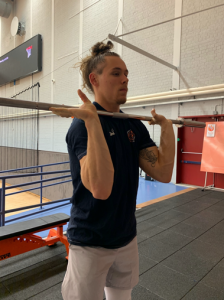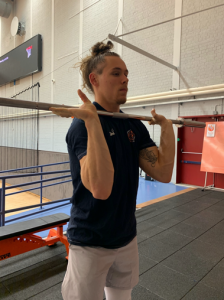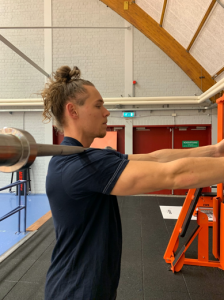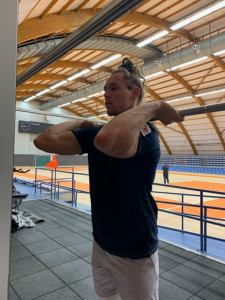“Coach, can I do something else instead of the Front Squats? I don’t have the mobility for them… My wrists just hurt too much if I hold the bar like that!”
Your wrists hurt? I wonder why..
What’s your first impression when/if you hear an athlete say something like that? Is the wrist the cause of the pain/discomfort? Or is it more likely to be an effect from a limitation elsewhere down the chain? If you’ve spent some time working in a weight room or any type of fitness-establishment for that matter, you’re likely to have heard some variation of the “my wrists hurt too much”. I personally consider that to be one of the bigger misconceptions about barbell movements.
To start off we’ll dive into this common misconception (read: the wrists being the cause/problem here). So, while the wrist can definitely be a restricting factor in any front rack-based exercises, we’re going to primarily be discussing why wrist discomfort generally is simply an effect of other deficiencies elsewhere down the chain. We’ll dive into some of these deficiencies as well as give some recommendations on how to improve them. That is, if we can and should even be improving the deficiencies themselves. Lastly, we’re going to discuss how we can adapt the exercises to the athlete, instead of the athlete to the exercises. As exercises are merely tools in a toolbox, we’ll provide alternative grips and ways to train effectively!
Starting off, there’s a minor clarification that we should probably make. We’re going to be looking at the barbell front rack position in healthy/uninjured athletes. There are various injuries that could limit the athletes’ ability to perform barbell front racked exercises, but we won’t be discussing the injuries, nor what we should do about them. We’ll be discussing limitations in movement, but for simplicity’s sake we refrain from discussing injuries as causes!
So, the Barbell front rack position? The details.
As we can see, the barbell is positioned BEHIND the Anterior Deltoid.
When we perform a Barbell Front Squat, we’re going to position a barbell on the anterior (front) side of the body. This requires the athlete to position the barbell behind the anterior deltoids. So basically, as the barbell is positioned behind the anterior deltoids, it gets as close to your throat as possible. If you were wondering, this is indeed one of the reasons why the Front Squat is an oh-so-comfortable lift to perform (5-Rep Max anyone?). Comfortable breathing, that’s for sure!
A common fault that athletes make about the front rack bar placement is that they position the bar too far forward. The barbell will be positioned either on top of the anterior deltoids or in rare cases even in front of them. So we want the barbell positioned behind the anterior deltoid. Reason being? Positioning it further forward puts excess stress on the shoulders, as this increases the demand to keep the shoulders in a constant state of flexion. It’s also considerably harder to lift any kind of weight, being that the barbell is unlikely to be positioned over the middle part of the feet.
Besides positioning the barbell behind the anterior deltoid, we need to raise the arm out in front of us. So, we’ll raise the arm forward relative to the torso in order to support the barbell. This is called shoulder flexion. If we were to lower our arms towards our midline the barbell would roll forward (off of the anterior deltoids). Which again is considerably harder to control. As such, a top priority in any grip variation for the front rack is going to be a flexed shoulder.
Lastly, it’s important that we also drive our elbows OUT. This creates external rotation in the shoulder joint, making it easier for us to maintain thoracic extension throughout the lift. I’ll generally cue ‘open up the chest’. But you as the coach putting the athlete’s elbows in a position where the shoulders are externally rotated will also work just fine. You’ll likely find that most athletes won’t find putting the shoulders into external rotation very comfortable, as most athletic populations will lack range of motion there. It’ll get better with time. Rather have them be a bit more uncomfortable than internally rotating the shoulder joint and consequently increasing the odds of flexion in the thoracic spine (a nice kyphotic little Quasimodo looking Front Squat, anyone?).
Just to clarify, these anatomical details constitute the classic front rack position for a barbell. But there is more than one way to grip the barbell, and we’ll use the Front Squat to describe those in just a little bit. Firstly, let’s dig a bit deeper into the mechanics of the Olympic style grip.
Olympic (Clean) grip and its limiting factors
The Olympic Grip. It allows us the most control over the barbell. If mastered, allows us to perform a ton of exercises from a front-racked position.
For most purposes of a barbell front racked position the Olympic grip will be the most beneficial. The Olympic grip allows the athlete the most control over the barbell in a front racked position. More control over the barbell means that we can lift more external load. But not only that, we’ll also be able to use the Olympic grip for Jerk variations, Cleans, Military Presses, Push Presses and much more. A prerequisite that we do need to consider (and a big one at that) is that the athlete must meet the mobility requirements that come with using the Olympic grip.
If the athlete has the required mobility, they’re setting themselves up for a vast array of exercise selections to work with. A.k.a. having more tools within the exercise toolbox. Unfortunately, the odds that athlete’s do indeed meet these mobility requirements are probably smaller than we would initially expect them to be. That’s largely because we have to look at a collection of factors that could hinder our ability to use the Olympic grip effectively. So, let’s dive into those factors, joint-by-joint.
Thoracic Spine
If our intent is to have a solid front rack position we’re going to undeniably benefit from a good bit of extension in the thoracic spine. While the thoracic spine is generally an area that’s supposed to be relatively mobile, in practice you’ll see your fair share of movement limitations in the thoracic spine area. Some athletes will be slightly limited in their movement capacities, while others might have a serious kyphotic posture. Especially the athletes with the latter posture will have a hard time getting into front racked lifts. Sometimes we’ll be able to work on generating a bit more thoracic extension, while other times it’s something we might not be able to address (meaning it’s a structural limitation). It’ll always take a deeper analysis of the athlete to determine whether it is structural or non-structural. But if there is little we can do about it, it’s important to consider what other tools we have available to use!
But generally, if we spend time on it, we can make some meaningful changes in movement in the thoracic spine. Before we get into HOW we can make these changes, we always need to consider the extent to which we can devote time and energy into making these desired changes. Our time/energy resources are scarce commodity and thus we need to be careful how we invest these resources. If we need to spend hours weekly to improve someone’s thoracic extension in order for them to perform front racked lifts, but it has no other performance benefits, it’s probably not the wisest of investments for resources of such a scarce nature.
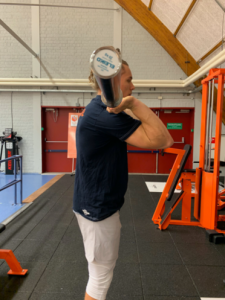
That’s a discussion for another day. Looking at the front racked position, we need that thoracic extension. So let’s look at a couple of my favorite ways to improve it!
Stretching whatever is stiff might feel relieving, but unless immediately acted upon, it won’t do much for us long term. So yes, the anterior deltoids and latissimus dorsi might be tight. Stretching them can help, but I personally have seen much bigger changes being made through strengthening the musculature that’s responsible for extending the thoracic spine.
So, without further ado!
Incorporate some Horizontal Pull variations. I love working with any upper body exercise that really drives some solid scapular retraction, such as Bent-Over Rows, Face Pulls and Inverted Rows. Strengthening the musculature that’s largely responsible for thoracic extension is probably pretty decent bang for your buck! And then to me, the most obvious path towards doing so is by strengthening the upper back musculature. If the athlete is able to, I think there’s value in doing variations of overhead presses here too. We’re going to be needing a decent amount of thoracic extension in order to get to advantageous positions in the overhead lifts. The Z-Press is a go-to for me here.
But also put some Zombie Front Squats, Holds or Carries into your programs. Regardless of the kind of movement we’re using it with, the Zombie position (one that we’ll discuss later) will force the athlete into a position that requires quite a bit of thoracic extension. And the beautiful thing: some solid carryover to improving front rack exercises as the movements are extremely similar. If we’re going to be ‘fixing’ the front rack position, these Zombie-exercises are probably going to be the most influential group of exercises we can do.
Shoulder
One of the bigger factors in limited front rack mobility is going to be the shoulder joint. From a movement perspective those deficiencies within the shoulder are probably going to be seen in the athlete’s ability to control external rotation and flexion. And if we’re going to be looking at limitations in external rotation and flexion, we’re going to have to take a deeper look at two muscle groups in particular. Those two groups will be the triceps brachii and the latissimus dorsi.
Taking a deeper look at the relevant anatomy, it makes sense why these muscle groups can impede our ability to flex and externally rotate the shoulder joint. Why? Well firstly, because the triceps and lats both function as shoulder extensors, meaning that they bring the arms down to the midline. With them being shoulder extensors, this implies that the triceps and lats function as antagonists to our ideal front rack position, which is one where we can raise the elbows up high enough to support a barbell (shoulder flexion).
But secondly, we also need to consider that the triceps also act antagonistically at the elbow joint, as the triceps serve as an elbow extensor. This is an antagonistic function obviously, as we need elbow flexion in the front rack position. But we’re not only looking at shoulder and elbow flexion, but we also have to dive deeper into another function of the lats. The lats (amongst many other functions) also work as shoulder internal rotators. Again, this another antagonistic function in the shoulder joint. This time it contradicts with the considerate amount of external rotation that we ideally want to see in a front rack position.
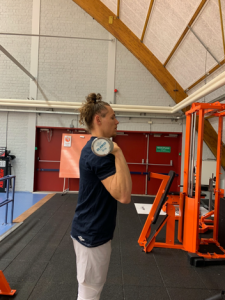
If we take a good look at the whole picture and we aim to assess which muscle groups could potentially be limiting factors in finding the ideal front rack position, the triceps and lats probably are the very first to come to mind. To conclude this part, remember that mindless stretching is probably not going to have the biggest long-term effect on improving these positions. I’d say that for a large crowd the biggest win will be to simply make the athletes train their lats and triceps through large ranges of motion instead of cutting movements short. We can add in any form of (dynamic) stretches to assist there, but…
In order for us to make any meaning changes, specificity will be king. Any drills where we can mobilize the lats and triceps within the position that we’re trying to improve are going to be hugely important. Look up any warm-up video on the All Things Gym or Hook Grip YouTube channels and you’ll walk away with more specific mobility drills than there are Harry Potter books!
Elbow & Wrist
Lastly, and to me least impactful/restricting: the elbow and wrist joints. I already mentioned the antagonistic function of the triceps at the elbow joint, and how this can affect the ideal positions we’re after. I’m not going to get into these two for too much longer, as they’re generally going to be much less frequently an actual impediment to a solid front rack position (barring previous injury) than the thoracic spine and shoulders. But simply put, we need to be able to extend the wrist and flex the elbow in order for us to get into our front racked position. And although the wrist and elbow can be limiting factors, generally when the thoracic spine and shoulders are mobile enough the wrist and elbow generally won’t be that much of a restriction.
So, alternative grips?
We’ve run through the front rack position, what it should look like and what can be reasons for limitations there. Now let’s just imagine you encounter some athletes who have restrictions in any of these aforementioned joints. What tools do we have at our disposal to still load the body without allowing these restrictions to play a significant role in hindering our ability to train? Next up we’ll take a look at a couple of variations that allow us to work around these restrictions.
Zombie & Cross-Faced Grip
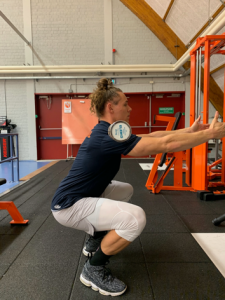
The Zombie & Cross-Faced Grips are probably my two favorite alternatives to the Olympic grip. Sometimes they’ll even reign supreme, as the self-restricting nature of these exercises makes them very valuable tools. On the other hand, compared to the Olympic grip we have significantly less control over the barbell using these grips. That’s a plus as much as it is a minus. In the overall picture we have to understand that less control means lesser ability to handle external load. Simply put, we can’t lift as heavy with these grip variations. If our goal is to maximize load in a Front Squat, then these grips might not be ideal. However, as we lose a bit of control, we are forced to execute the lifts perfectly (self-restricted nature of exercises). Because if we don’t execute the exercises properly, that barbell is going to be anywhere but on our shoulders.
For example’s sake: Athlete A loses thoracic extension, barbell rolls forward. Athlete B shoots hips up early coming out of the bottom of their squat, barbell rolls forward.
So these two grips are largely self-restricting, meaning that inefficient technique won’t allow us to execute the movement. It teaches the athletes how to squat with minimal coaching intervention. Is it going to be best to lift heavy? No. Is it going to be one of the better tools to teach movement? Absolutely.
But when should we be using the Zombie or Cross-Faced Grips? Besides using them as self-restricting exercise selections, we can also use it for athletes that lack mobility elsewhere down the chain. As an example, if an athlete has restrictions in wrist extension or elbow flexion, the Zombie and Cross-Faced Grip allow them to still keep the bar in a front racked position. If an athlete’s triceps are restricted, we can take away some of the tension by not simultaneously flexing the shoulder and flexing the elbow (as we are able to extend the elbow in the Zombie grip, for instance). These grips allow us to perform front racked exercises, even when we are dealing with many of the movement restrictions that would hinder us from using the Olympic grip!
Strap Grip
The Strap Grip is probably one of the easier set-ups to use, and it requires very little mobility in the joints that we’ve discussed up until this point. The only thing we’re going to need is well, a pair of weightlifting straps! If you have them, you have a relatively stable option to lift heavier loads with little stress on the wrists.
Reverse SSB
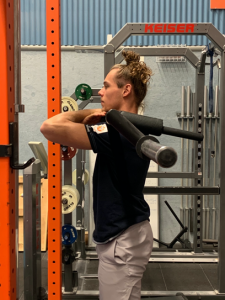
While the Reverse Safety Squat Bar Hold has some popularity within the Powerlifting world, I haven’t seen it implemented nearly as frequently in athletic development. You probably won’t find a bunch of Safety Squat Barbells laying around in most weight rooms, so the implementation of them can be difficult to do in a group setting. But if you do have one to your disposal then they’re a very serviceable tool to use. I have to say that the Reverse Hold is one of my favorite ways to use the Safety Squat Bar. Not only that, it’s probably one of my favorite ways to load the Front Squat for athletes who are unable to use the Olympic grip.
Athletes often dislike the feeling of a conventional barbell in a front rack position. Having an enjoyably mushy pad on the Safety Squat Bar sure takes away that discomfort. Hey, it’s an advantage! But on a more serious note: similarly to the Zombie and Cross-Faced grip variations the Reverse Safety Squat Bar Hold is relatively self-restricting. Move less than ideally and the athlete will surely experience the consequences. But in contrast to the Zombie and Cross-Faced grips the Reverse Safety Squat Bar will actually feel pretty darn stable on the shoulders. And thus we can really load up our lifts!
To wrap up…
Ideal World
Let’s consider an alternative universe. In our charming little alternative universe we encounter the Ideal World. In the Ideal World we only spot two distinct categories of athletes. Athletes that fall under the first category have perfect mobility. They are able to move through maximal attainable ranges of motion for all joints in the body and are also able to stabilize their joints in these end ranges. We are able to use a vast array of exercises, including the Olympic grip on barbell front racked exercises. Fantastic! The second category of athletes lack this wonder of maximal ranges of motion and therefore lack the sufficient mobility to utilize the Olympic grip. Sounds very much like our not-so-alternate universe. But there is one particular feature about these second category athletes that we need to discuss. And that’s the fact that none of these restrictions are going to be structural, and that available time to address the range of motion restrictions is plentiful. So how do we address these restrictions in our alternate universe? We use alternative exercises that offer value such as the Zombie Grip or Reverse Safety Squat Bar Hold to load up our big-time exercises. And as we’re loading using alternative exercises, we address our range of motion restrictions through targeted mobility work. Doesn’t that sound ideal?!
It’s a What-Can-You-Do-For-Me-Today kinda World.
Back to Planet Earth, shall we? Such a lovely planet where we encounter an infinite amount of categories of athletes. With that being said, in the real world movement restrictions are probably the least of your worries, time availability and adaptive energy are probably even more important to consider! We need to be wary about how and when we use these immensely scarce resources. So how we approach limitations and what we invest in improving them is just as important.
We’ll come across situations where athletes are structurally restricted in movement. That means that they will never be able to utilize the Olympic grip effectively. And that’s fine. A coach with a large toolbox to pick and choose from will have plentiful variations that still allow us to gain the desired adaptations. We’ll also come across situations where time is too much of a restriction and we can’t invest into improving (non-structural) movement limitations. If you have two hours of training time available each week, is it really worth your time to invest into improving one’s front rack position? Or maybe it is better to load them with the Zombie Squat and call it a day?
Whatever we choose to do, I think that it’s important to understand why athletes might be restricted in their ability to use the front rack position. Especially if front racked exercises such as Front Squats, Cleans, and Jerks are integral aspects of your programs. Analyze their movement capacity through a joint-by-joint approach until you find the restricting factor. Once you do, attack that factor until it is not limiting the exercise’s ability to drive the adaptation! And remember, tools in the toolbox. Always think bigger picture. If it doesn’t work, it just doesn’t work!

Make sure to give him a follow on Instagram at: @yoeripegel
Enjoy the content? Then you should check out The Strength Coach Network!
We built The Strength Coach Network to provide you three ways become the best practitioner possible. First, each month we add a new lecture from one of the best practitioners in the world to help keep you and your staff up to date with what the best of the best are doing with their athletes RIGHT NOW! Secondly, the forum provides you a new avenue to connect with practitioners around the world to find a unique point of view from coaches all over the world when it comes to career advice, training ideas, or any aspect of our lives in coaching. Finally, you get exclusive discounts on all products CVASPS related, INCLUDING your seat at The Seminar! When you add those three in with our library of over 100 sensational lectures, including all of those from The Central Virginia Sport Performance Seminar, you have found your one stop shop for continuing education for you and your staff. Make sure you hop over today and get your first 48 hours for only $1 by using the link here: https://strengthcoachnetwork.com/cvasps/
#StrengthCoach, #StrengthAndConditioningCoach, #Podcast, #LearningAtLunch, #TheSeminar, #SportsTraining, #PhysicalPreparation, #TheManual, #SportTraining, #SportPerformance, #HumanPerformance, #StrengthTraining, #SpeedTraining, #Training, #Coach, #Performance, #Sport, #HighPerformance, #VBT, #VelocityBasedTraining, #TriphasicTraining, #Plyometrics

